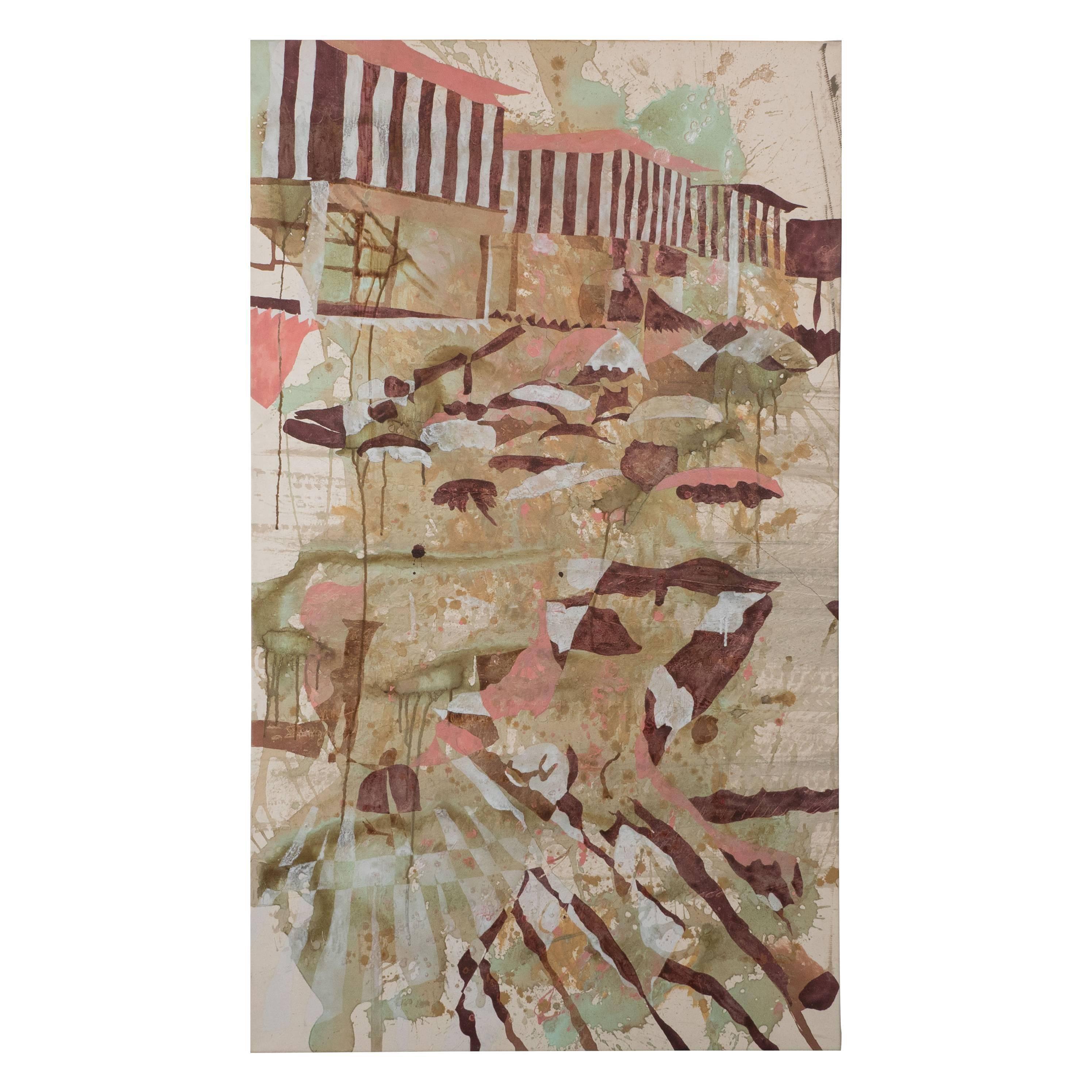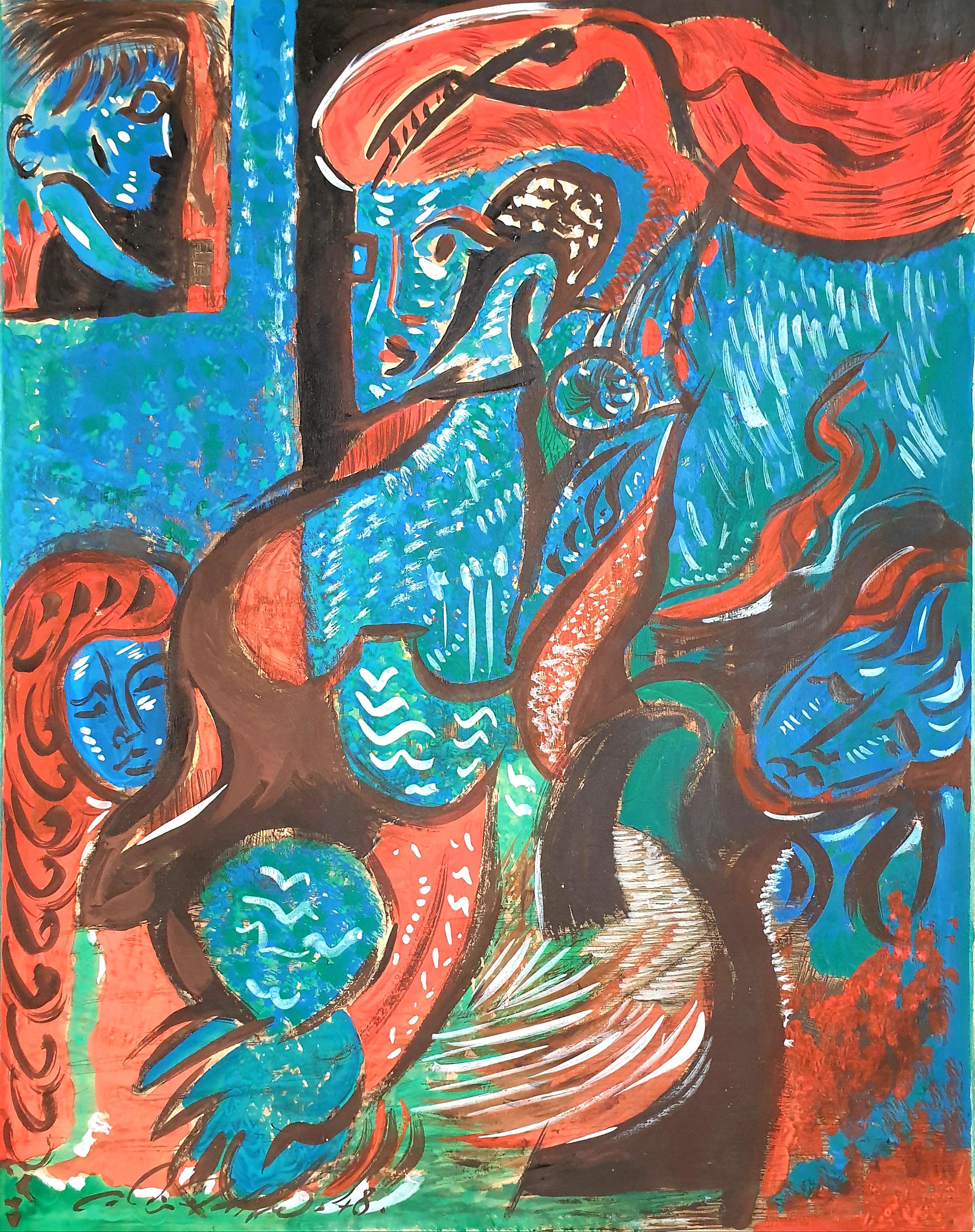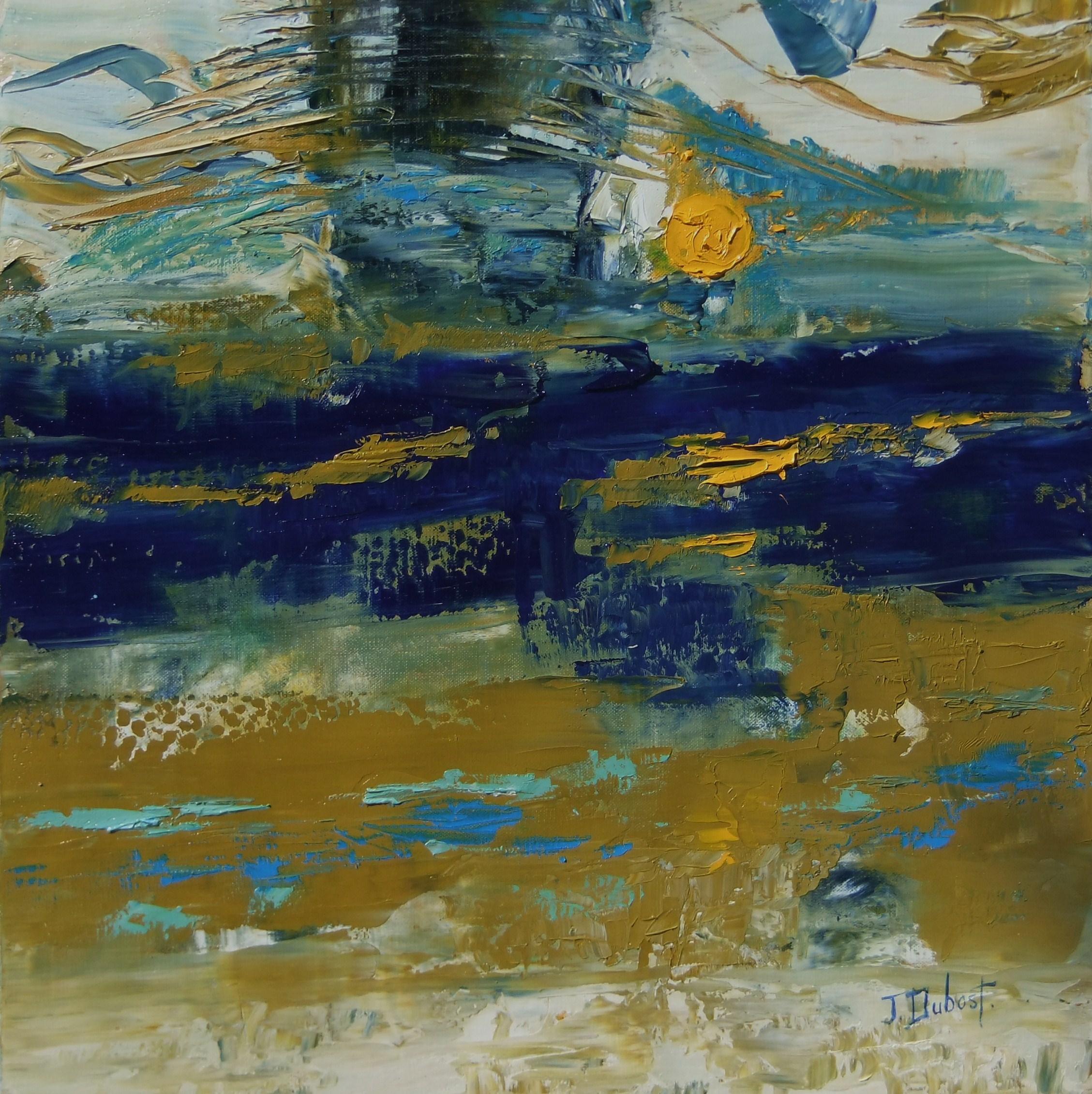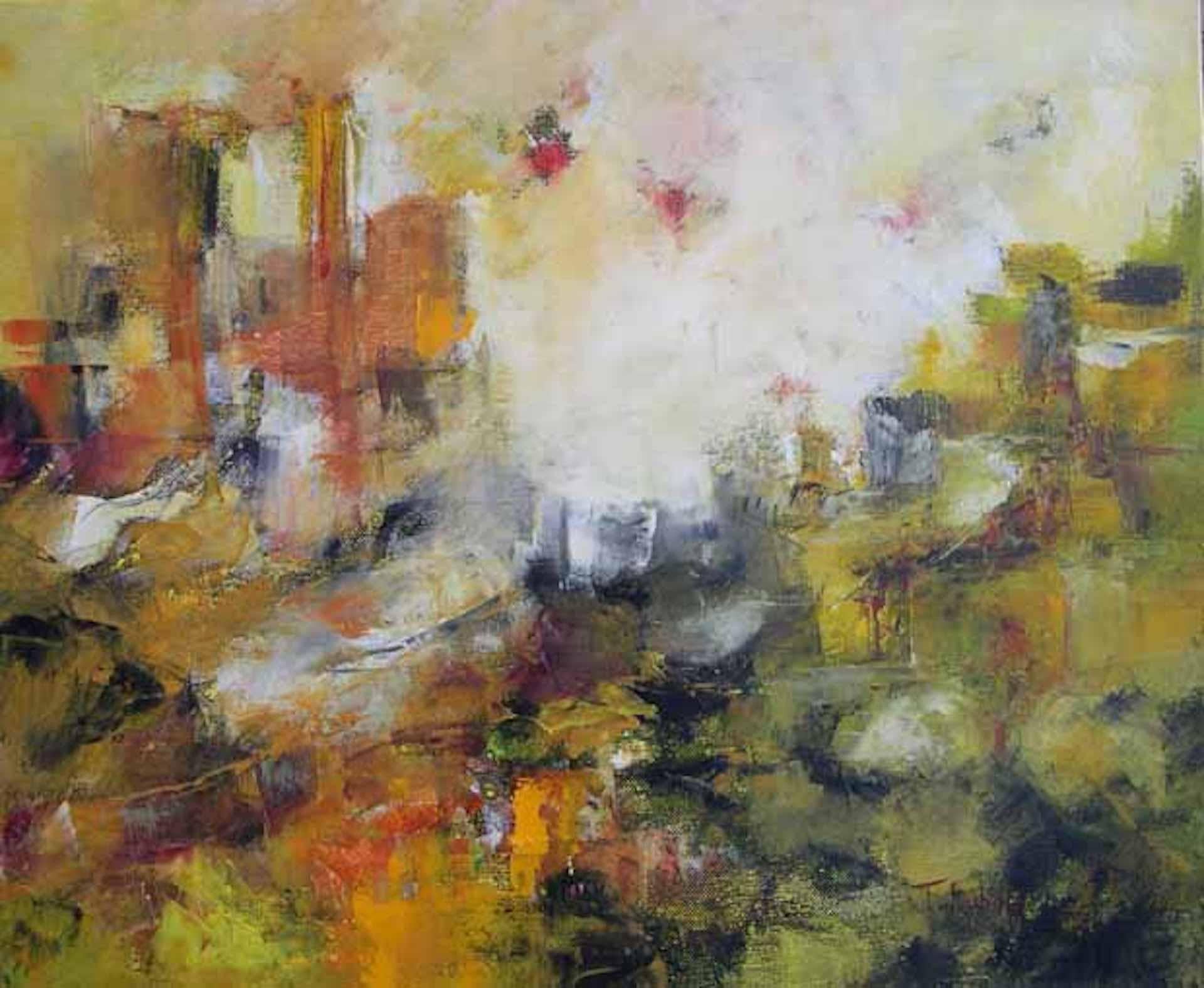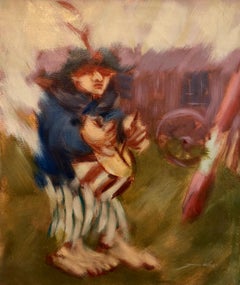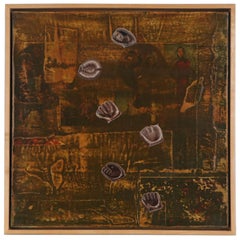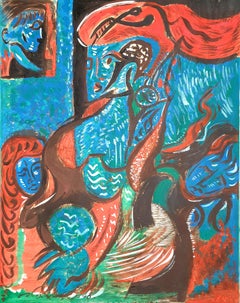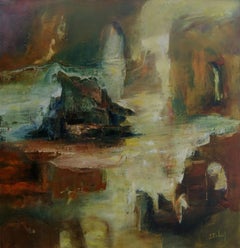
Spanish Catalan Modernist Oil Painting Drummer Boy Figurative Abstraction
View Similar Items
Want more images or videos?
Request additional images or videos from the seller
1 of 9
Artur DuchSpanish Catalan Modernist Oil Painting Drummer Boy Figurative Abstraction1984
1984
About the Item
- Creator:Artur Duch (1951, Spanish)
- Creation Year:1984
- Dimensions:Height: 21.75 in (55.25 cm)Width: 18.5 in (46.99 cm)
- Medium:
- Movement & Style:
- Period:
- Condition:unstretched. minor wear.
- Gallery Location:Surfside, FL
- Reference Number:1stDibs: LU3823200001
About the Seller
4.9
Platinum Seller
These expertly vetted sellers are 1stDibs' most experienced sellers and are rated highest by our customers.
Established in 1995
1stDibs seller since 2014
Typical response time: 1 hour
More From This SellerView All
- Spanish Catalan Modernist Oil Painting Drummer Boy Figurative AbstractionBy Artur DuchLocated in Surfside, FLArtur Duch Puig, born 1951 in Sitges In 1971 he started studying at the St. Jordi School of Fine Arts in Barcelona. There he developed his artistic skills in the fields of sculptu...Category
20th Century Post-Modern Figurative Paintings
MaterialsCanvas, Oil
- Abstract Mixed Media Collage Oil Painting Sports, Leather Baseball MittsBy Patrick LoCiceroLocated in Surfside, FLTitle: (Baseball) Mits 25.5" W x 25.5" H x 2.25" framed; canvas measures 24" W x 24" H. Provenance: The Rails Collection, Washington, DC (with their label verso) This depicts floating baseball gloves inn an abstract pattern. This is not signed on the front and might be signed verso. We have not examined out of frame. Patrick LoCicero was born in Youngstown, Ohio, in 1959. He attended Youngstown State University, Ohio, and the Columbus College of Art and Design. He completed a B.F.A. at Ohio State University in 1982 and an M.F.A. at the San Francisco Art Institute in 1986. His paintings, installations, prints, and multimedia work have been shown in California, Pennsylvania, and Ohio. LoCicero's richly layered imagery is characterized by unusual juxtapositions of everyday objects and classical motifs, which play with the viewer's perception of materials and subjects. LoCicero’s assemblage paintings combine collage with painting. The overlap and collage elements relate directly to the images he depicts, guiding him in his choice of subjects, and come from a variety of sources including the Kama Sutra, antique children’s books...Category
21st Century and Contemporary Contemporary Abstract Paintings
MaterialsCanvas, Mixed Media, Oil, Acrylic, Laid Paper
- Large Figurative Abstract Expressionist Textured Painting Adolf BencaLocated in Surfside, FLAbstract oil painting on stretched canvas featuring figures against a dark brown background. Signed upper left. Adolf Benca was born in Bratislava, Slova...Category
20th Century Abstract Paintings
MaterialsCanvas, Oil
- Judaica Modernist Oil Painting 'Know Thyself' Israeli Kibbutz Pioneer, ProphetBy Mortimer BorneLocated in Surfside, FLMortimer Borne, Printmaker, painter, sculptor, and educator was born in Rypin, Poland in 1902 and emigrated to the US in 1916. He studied at the National Academy of Design, The Art Students League, The Beaux-Arts Institute of Design, and with Charles Webster Hawthorne, founder of the Cape Cod School of Art in Provincetown. Painted in a thick impasto style similar in technique to Samuel Rothbort and David Burliuk. Borne himself taught at The New School for Social Research in New York City from 1945-1967. From the 1920s through the 40s he was a prolific producer of New York City cityscapes and genre scenes. In later decades, he adopted a more modernist style apparently influenced by Picasso, producing color drypoints of abstracted figures. His works were widely exhibited in museums in the U.S. and abroad from 1931 and later, including the Art Institute of Chicago, the American Institute of Graphic Arts, Museum of Modern Art, Metropolitan Museum of Art, Corcoran Gallery of Art, New York Public Library, Carnegie Institute, and Royal Society of Painters, Etchers and Engravers in London. He taught at The New School for Social Research in New York City from 1945-1967, and at the Tappan Zee...Category
1970s Modern Figurative Paintings
MaterialsCanvas, Oil
- French Jewish Post Holocaust Abstract Painting Manner of Hundertwasser Art BrutBy Jichak PressburgerLocated in Surfside, FLJichak Pressburger, Painter. b. 1933, Bratislava, Czechoslovakia. A concentration camp survivior. Came to Israel aboard the ship, "The Exodus". 1964 Went to Paris. In 1979 Returned as new immigrant. Education Tel Aviv University, B.A. in art, with Marcel Janco and Isidor Ascheim at Avni art school. Beaux Arts, Paris with Professor Coutaud. Itzchak Pressburger Stays in Paris from 1963 – 1979, Resident of the “Cité des Arts” 1969-1972. Lives and works in Jerusalem since 1979. One-Man Exhibitions 1963 Gallery Dugit, Tel-Aviv 1968 Cultural Center Enkhuizen, Netherlands 1968 Gallery Zunini, Paris (chosen by the art critic of « Opus : Jean-Jacques Lévèque) 1970 Gallery Zunini, Paris 1973 Gallery Maitre Albert, Paris. Cultural Center Verfeil sur Seye, France 1974 Gallery Maitre Albert, Paris 1976 Gallery Mundo, Barcelone 1980 Artists’ House, Jerusalem 1981 Gallery Alain Gerard, Paris Group Exhibitions 1966 Rathaus Charlottenburg, Berlin. (The first show of Israeli painters in Germany Artists Center of Silvarouvres, Nantes, Ffance XXXth Salon of Finances at “l’Hotel des Monnaies”, Paris 1969 Maison de Culture, Le Havre, France 1968 Gallery Zunini, Paris (chosen by the art critic of « Opus : Jean-Jacques Lévèque) Salon « Grands et Jeunes d’Aujourd’hui », Paris Museum of Fine Arts, Nantes, France Cultural Center Vitry, France Gallery Il Giorno, Milan Cité des Arts, Paris 1972 Salon “Grands et Jeunes d’Aujourd’hui”, Paris Salon de Mai, Paris 1973 Städtische Galerie, Siegen, Germany 1974 Jewish Cultural Center, Paris Publicis, Paris 1975 Réalitiés Nouvelles, Paris 1976 Salon de Mai, Paris 1977 “Perspectives Israeliennes”, Grand Palais, Paris 1981 Salon Alain Gerard, Paris 1984 Artists’ House, Jerusalem Publication 1990 Haggadah Yom Kippour (Hebrew/French) Abraham Bliah (private edition), Paris Acquisitions 1968 The City of Paris 1972 The State of France The Yitzchak Pressburger artist was born in Bratislava – known for centuries by its German name of Pressburg – but the outbreak of World War II found him and his family in Prague. His father realized they had to escape from the Nazi occupiers and tried to get the family across the border into Hungary. However, they were caught near the crossing point, arrested and incarcerated overnight at the nearby railway station. The Czechs put them on a train to Hungary early the next morning. That was their first miracle in their quest for survival. They survived with relative ease until late 1943, when the father was taken away to a forced labor camp. He subsequently died in a death march. Things became even more precarious in early 1944, when the Holocaust made its full-blown presence felt in Hungary. “It wasn’t the Germans, it was the Hungarian Nazis who did the dirty work,” Pressburger points out. The family lived in so-called “safe houses” that were protected by Switzerland, Finland and Sweden. The havens were dismantled in late 1944, and the Pressburgers moved into one of the two Jewish ghettos in Budapest. The Nazis had found two houses with Jews, including the one where we had been, and took them all out and shot them next to the Danube. Today there is a monument by the river [called Shoes on the Danube Bank]. We should have been with the Jews who were killed by the river,” he says. After the war, Pressburger and his siblings were farmed out to various orphanages run by the Jewish Agency, and things took a decidedly better turn. “We finally had food to eat,” he recalls. “After a while we were put on trains that were protected by the Jewish Brigade [of the British Army], and we were sent to Austria, and then to Germany.” “My uncle was a famous artist, and I learned a lot from him,” he says. While in Germany, Pressburger also took some lessons with a local artist. His mother managed to get him and two of his siblings berths on the Exodus, which set sail from Marseilles for Palestine in July 1947. Pressburger was 13 at the time and clearly recalls the aborted attempt to get to the Promised Land. “It was so crowded on the boat. This was a ship that was made to ply rivers in the United States, with a few hundred people on board, and we had over 4,500 passengers crammed in.” As we know, the British prevented the Exodus from docking in Palestine, and the passengers were shipped – in three far more seaworthy vessels – back to France. After the French government refused to cooperate with the British, Pressburger and the others found themselves back in Germany. The teenager eventually made it here in 1948, just one month before the Declaration of Independence. After a short furlough in Tel Aviv, during the first lull in the fighting in the War of Independence, he moved to Kibbutz Kfar Ruppin, where he worked in the cowshed. All the while he continued feverishly drawing and honing his artistic skills, which he says came in handy when he joined the IDF. After completing his military service, which included a spell as one of the founding members of the Flotilla 13 naval commando unit, he worked in Sdom for a while at the Dead Sea Works before starting his formal arts training in earnest. I was in the first group of students at the Avni Institute [in Tel Aviv],” he says. “There was quite a famous bunch of students and teachers like Moshe Mokadi and Isidore Ascheim and Aaron Giladi.” In such illustrious company, one might have thought Pressburger was set to unleash his burgeoning talents on art connoisseurs across the globe, but it was a while before that happened. Pressburger arrived in the French capital in 1964 and spent close to 15 years there, with a short interlude in Germany, before returning to Israel. His time in Paris was a professionally rewarding period of his life, and he also found love. “[Avni Institute teacher] Yochanan Simon gave me the name and address of a French-Israeli family in Paris, but when I got to the house, a young woman opened the door and told me the family was on vacation in Israel,” he explains. Despite missing his expected hosts’ welcome, he and the German-born young lady who greeted him soon fell for each other, and romance quickly led to wedding bells. By all accounts, Pressburger did well in Europe. He secured a rare three-year berth at Cité Internationale des Arts, where artists are normally provided with accommodation and studio space for between two months and a year. He was also accepted to the prestigious Beaux Arts academy of fine arts, mounted solo exhibitions, and took part in group shows all over Europe. One of these last was a group exhibition at Rathaus Charlottenburg in Berlin in 1966 – the first exhibition of Israeli artists in Germany after the Holocaust. When he arrived in Berlin, the lineup for the Israeli show was already signed and sealed, but somehow his work came to the attention of the German culture minister, who arranged for him to join. The Pressburgers’ year-long sojourn came to an abrupt end following an encounter he had one day while walking through the crowded Berlin streets...Category
1960s Expressionist Abstract Paintings
MaterialsCanvas, Oil
- Large Colorful 1983 Neo Expressionist Roberto Juarez Oil Painting Tron FamilyBy Roberto JuarezLocated in Surfside, FLRoberto Juarez, (American, 1952- ) Tron Family. 1983. Signed, dated & titled. Oil and oil stick on canvas. Provenance: Robert Miller Gallery, NY., Mira Godard Gallery, Toronto, Ontario, CA Roberto Juarez (born 1952) is an American visual artist known for his paintings, murals, and mixed-media works. Born in Chicago, (parents of both Mexican and Puerto Rican Latino heritage) Juarez received his B.F.A. at the San Francisco Art Institute (1977) and pursued graduate studies in Television and Film at the University of California, Los Angeles. Juarez frequently employs painterly floral motifs, which are inspired by the traditions of Hispanic, Latin American and non-Western painting. Roberto Juarez has been a significant presence in the art worlds of New York, Miami, Colorado, and beyond since the early 1980s. In 1978, Juarez completed his graduate thesis for UCLA in Paris and decided not to return to L.A. Juarez relocated to New York City, where in 1981, Ellen Stewart offered Juarez a former garage owned by La MaMa Experimental Theatre Club as an artist studio. The space, which had no water or electricity, was offered to Juarez rent-free, provided that he clean and maintain it. He was active in the Neo Expressionist era of the the late 1980's along with Julian Schnabel and David Salle. Throughout the 80s and 90s Juarez painted the branching forms of trees and flowers. While living in Miami in the 90s, Juarez began to incorporate peat moss, rice paper, and other natural materials in his canvases. Since 2000, and his move from Miami back to New York, Juarez's imagery turned more abstract, typically featuring geometric forms and systems. In a review from this period, art critic Grace Glueck noted that his works feature “a contrast between the softness of the grounds – blends of transparent and opaque materials in muted colors – and their strong geometric-organic motifs." In his use of elements of nature to portray an idyllic unity, Juarez looks back to such early-20th-century painters as Franz Marc and Henri Matisse. He has done prints with Shark’s Ink Studios in Lyons and Anderson Ranch Arts Center as well as Tamarind Institute. Roberto Juarez is a visual artist who has been active in the areas of painting, printmaking, drawing, and large-scale public commissions throughout his career. His work has been exhibited throughout the United States and Mexico, and is included in major museum collections such as the Brooklyn Museum, the Metropolitan Museum of Art, El Museo del Barrio, the Denver Art Museum, the Kemper Museum of Contemporary Art, the Los Angeles County Museum of Art, Pérez Art Museum Miami, the Newark Museum, and the Speed Art Museum. He has completed public art projects and murals for the Miami International Airport, Grand Central Terminal, the Miami-Dade County Courthouse, Whitman College, and the University of Michigan College of Engineering. Juarez won the Prix de Rome in 1997 and was a Guggenheim Fellow in 2001-2002. Select Solo Exhibitions Boulder Museum of Contemporary Art, Boulder, CO La MaMa Galleria, New York, NY Pace Prints New York, NY Charles Cowles Gallery, New York, NY Kemper Museum of Contemporary Art, Kansas City, KS Museum of Contemporary Art, North Miami, FL, Bonnie Clearwater, Curator and Author Robert Miller Gallery, New York, NY Fredric Snitzer Gallery, Miami, FL Galeria Ramis Barquet, Monterrey, Mexico Richard Green Gallery, Santa Monica, CA Stephen Wirtz Gallery, San Francisco, CA Andre Emmerich Gallery, Zurich Mira Godard Gallery, Toronto, Canada San Francisco Art Institute, San Francisco, CA Select Group Exhibitions 2018 May China 2018, China National Academy of Painting, Beijing, China 2017 Love Among the Ruins, 56 Bleecker Gallery and Late 80's New York, Howl! Arts Incorporated, New York, NY 2015 Inside the Episode: curated by Jack Pierson, Launch F18 Gallery, New York, NY 2015 MTA Arts Design Illustrates the City, The Museum of American Illustration at The Society of Illustrators, New York 2015 The Annual; National Academy Museum, New York, NY 2008 One of a Kind; Monoprints & Monotypes, Spencertown Academy Art Center, Spencertown, New York 2001 Roberto Juarez and Julio Galan...Category
1980s Neo-Expressionist Abstract Paintings
MaterialsCanvas, Oil Crayon, Oil
You May Also Like
- Contemporary Painting "Contagian" by Molly Dilworth, Acrylic on Canvas, 2009By Molly DilworthLocated in New York, NYMolly Dilworth "Contagian". Acrylic on canvas created in 2009. Measures: 35.5" W X 60.25" H. Signed on revers "Molly Dilworth/2009". This striking painting depicts what first appe...Category
Early 2000s Post-Modern Abstract Paintings
MaterialsCanvas, Acrylic
- 'Motherhood' A Redhead Beauty with Children. Mid-century Oil on Paper.Located in Cotignac, FRMid-century post modern oil on paper of a woman with children. Signed and dated 1948 to the bottom left, (the artist as yet undiscovered). An arrestin...Category
Mid-20th Century Post-Modern Figurative Paintings
MaterialsPaper, Oil
- French Contemporary Art by Josette Dubost - Arches MarinesBy Josette DubostLocated in Paris, IDFJosette Dubost is a French artist born in 1936 who lives & works in Solliès-Pont, France.Category
2010s Contemporary Abstract Paintings
MaterialsCanvas, Oil
- French Contemporary Art by Josette Dubost - HorizonBy Josette DubostLocated in Paris, IDFJosette Dubost is a French artist born in 1936 who lives & works in Solliès-Pont, France.Category
2010s Contemporary Abstract Paintings
MaterialsCanvas, Oil
- French Contemporary Art by Josette Dubost - DivagationBy Josette DubostLocated in Paris, IDFJosette Dubost is a French artist born in 1936 who lives & works in Solliès-Pont, France.Category
2010s Contemporary Abstract Paintings
MaterialsCanvas, Oil
- French Contemporary Art by Josette Dubost - Hier Demain?By Josette DubostLocated in Paris, IDFJosette Dubost is a French artist born in 1936 who lives & works in Solliès-Pont, France.Category
2010s Contemporary Abstract Paintings
MaterialsCanvas, Oil
Recently Viewed
View AllMore Ways To Browse
Master Spain
Madrid Spain Painting
Oil Paintings 1971
Sale Spanish
Mexican Spanish Painting
Mexican Boy
Catalan Spanish
Spanish Oil On Wood
Catalan Art
Spanish Modernist
Belgian Modernist
Spanish Valencia
Post Modernist Painting
Small Modernist Painting
Catalan Paintings
Musicians Modern Painting
Vintage Car Painting
Small Antique French Paintings

